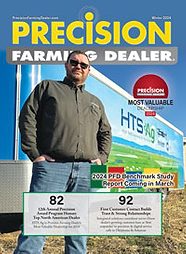As farmers move to new crop-production practices, such as narrow rows and higher plant populations, or look for ways to increase planter capabilities, manufacturers are working to address these trends with the latest in planter technology.
Harry Stine, owner of Stine Seed Co. in Adel, says narrow rows and high plant populations are part of his vision for feeding a growing world population — producing more food on fewer acres.
The company has started the process of breeding for and identifying corn hybrids that will be able to handle the narrower-row, higher-population environments.
“Narrower rows and higher plant populations will allow growers to better utilize the resources they have available, resulting in more bushels per acre and increased profitability,” says Stine.
Last year, Stine Seed Co. planted 2,500 acres of seed corn and conventional corn in 12-inch rows.
For equipment, the company used John Deere and Great Plains narrow-row planters. This year, Stine plans to expand the project.
In addition, Stine also has begun converting its soybean research operations to 20-inch rows or narrower.
Twin-Row from Case IH
This past fall, Case IH introduced twin-row planters because of increased interest in this concept and the potential yield advantages.
Case IH twin-row planters allow producers to increase plant populations without having to make new investments or major modifications to existing harvesting or spraying equipment.
Essentially, you change your planter and everything else remains the same as it was with 30-, 36-, 38- or 40-inch rows.
The concept involves staggering seed in two rows, eight inches apart on 30-, 36-, 38- or 40-inch centers. Therefore, a corn head set for 30-, 36-, 38- or 40-inch rows can harvest twin rows at the same time.
This technology can be for corn but also can be used with other row crops, such as soybeans, cotton, milo and sunflowers.
“A twin-row planter is a viable option for farmers who want to increase plant populations without having to make any new investments or major modifications to existing harvesting or spraying equipment,” says Bill Hoeg, Case IH planter sales and marketing manager in North America.
Bigger Capacity and Tracks
AGCO White planters model 8936-30 were the industry’s first large-acreage row-crop planter available with factory-installed rubber tracks, the company says.
This is a 36-row planter with 30-inch row spacing and is equipped with 30x67-inch rubber transport tracks plus four large gauge wheels on each wing to significantly reduce soil compaction compared to similar planters equipped with wheels.
“As farm operations increase in size, producers are asking for larger planters capable of covering more ground, but soil compaction with larger equipment is always a concern,” says Gary Hamilton, senior product specialist for White Planters.
The White 8936-30 can carry 150 bushels of seed in its central-fill system, which has two 75-bu. bulk-seed hoppers.
Three-section variable-rate hydraulic seed drives are controlled by a microprocessor, and the planter offers pneumatic row unit down pressure and a GPS-compatible automatic row-shutoff system as standard equipment.
The machine was designed specifically to ensure the row units would accept row unit-mounted tillage coulters and residue-management attachments and granular-chemical attachments.
Two optional 750-gallon liquid fertilizer tanks also can be mounted on the planter for fertilizer applications.
In addition, the 8936-30 can fold to a width of 15 feet for easier transport.
Latest from Kinze
Kinze Manufacturing is answering the demands for a higher-capacity planter that is easy to maneuver. Its new 4900 planter series has a new narrow transport front-fold frame design, 30-inch row spacing and a choice of 12, 16, or 24 rows.
Research found farmers want state-of-the-art technology with superior agronomic performance with a unit with more vertical travel, noted Rhett Schildroth, product manager for Kinze.
A new patent-pending seed meter offers 99 percent accuracy at speeds from 2 to 8 mph. The meter is available with contact drive, hydraulic drive and — new with the 4900 planter — electric drive.
An electric drive means there are no chains, clutches, gearboxes or shafts to maintain.
The new planter frame has 42 degrees of wing flex (21 degrees up, 21 degrees down) to offer better contact on rolling terrain and terraces. A new bulk-fill tank design provides the 16- and 24-row planters with a 120-bu. capacity while the 12-row offers 90-bu. capacity.
With up to 120 bu. of seed and 500 gal. of liquid fertilizer capacity, the 4900 planter allows farmers to continue planting for long periods without having to stop and refill.
Since maneuverability is important to farmers, Kinze incorporated an industry exclusive flip-axle option for the 24-row planter to significantly reduce hitch weight and make it easy to move in and out of fields.
The 4900 series planters will be available for orders in May for use during the 2014 planting season.


![[Technology Corner] Future of Drone Use in U S Brighter After FAA Regulation Change](https://www.precisionfarmingdealer.com/ext/resources/2024/04/11/4-12-24-Slides_OTR14.jpg?height=290&t=1712932011&width=400)



Post a comment
Report Abusive Comment